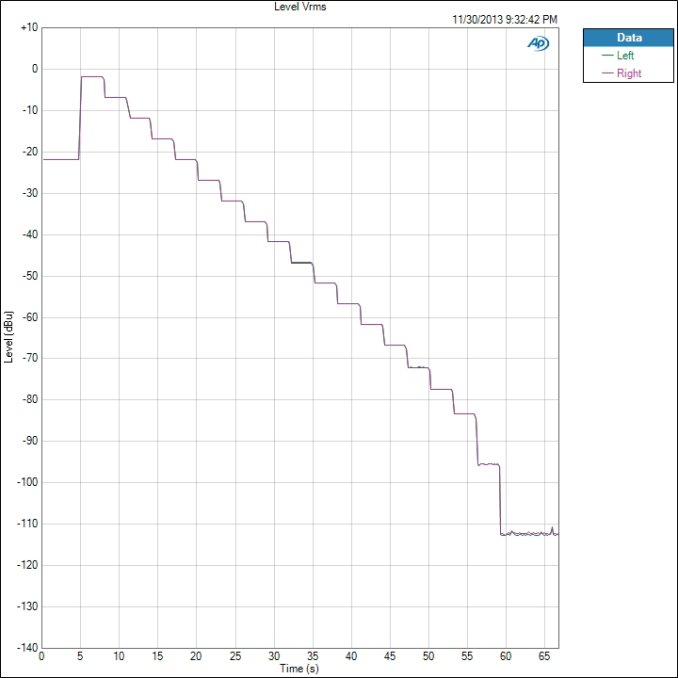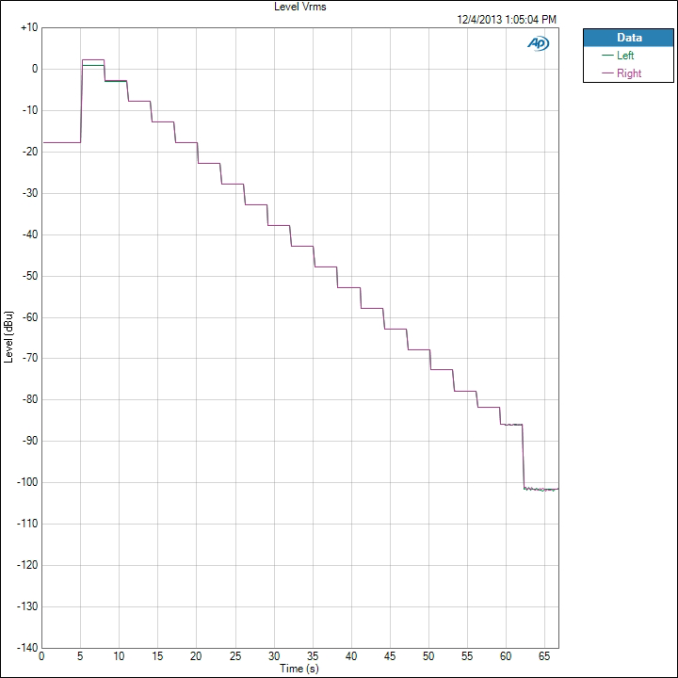Smartphone Audio Quality Testing
by Chris Heinonen on December 8, 2013 5:15 PM EST- Posted in
- Smartphones
- Audio
- Mobile
- Tablets
- Testing
Dynamic Range
The dynamic range of the phone indicates the difference between the loudest possible sound and the background noise. The more residual noise in the background, the lower the dynamic range. Phones with more powerful amplifier sections will typically produce a greater dynamic range. The residual noise level is often constant, so as the overall volume level increases the difference between the music and the noise increases as well.
The best performer here is the iPhone 5 again, with 92.214 dB of range. The worst is the Nexus 5 with only 89.332 dB. A difference of 3 dB is not something I would concern myself over. If we see a phone or tablet that drops down below 80 dB then I will start to show more concern.
Crosstalk
Crosstalk, like dynamic range, is just a number here. This is the measurement how much signal leaks from one channel into another. If an instrument should only be in the right ear, some of that signal will leak into the left ear, but we want that as low as possible. The results are expressed in -dB, or how much quieter one ear is than the intended ear.
On the Note 3 we see a wonderful crosstalk measurement of -117.2 dB so the sounds in one ear are -117 dB quieter in the other ear. This makes them impossible to hear. The worst is the iPhone 5, with only -75.624 dB of isolation.
Stepped Response
The stepped response uses a 1 kHz 0 dBFS tone but measures output level from maximum volume to minimum volume. We can see how large the volume steps are and how many there are. It doesn’t produce a number we can use, but it ties back into our other results. For a good example, we can look at the Note 3.
We see steps that are around -5 dBu each. The final level is muted and just the background noise of the device. Each step is clean and even but as we get lower and lower we see noise start to intrude. This is the background noise starting to become audible in the signal. The flatter the levels are, the quieter it will be. Now, let us look at the Nexus 5.
Notice at the very top how the right and left channels do not overlap. That is the clipping we talked about at the very beginning. It isn’t until the 4th volume setting that the level difference is down to nothing. Because of this, I would consider the top 3 volume settings of the Nexus 5 as ones that should be avoided. They each have enough THD+N introduced into them that it will sound poor, and one ear will be louder than the other.












188 Comments
View All Comments
Scootiep7 - Wednesday, December 11, 2013 - link
Wonderfully well thought out and written article. Thank you! FFora future article my one request would be for a llcomparrison of all phones on each test parameter instead of only comparing 2 or 3 on some metrics. Again, thank you!qualitycounts - Wednesday, December 11, 2013 - link
Thank you so much for doing this testing. It would also be very helpful if your wrap up section did some side by side comparisons, kind of like they do on Consumer Reports. It's very hard from this article to tell which one comes out on top. Also, it would be nice to see an audio/phone quality report on the HTC One since it is also one of the most popular smartphones available.sergoliv - Wednesday, December 11, 2013 - link
In my opinion, audio quality testing is a very welcome adition to Anandtech. I am maily a classical music listner. Good dynamic range, wide and flat frequency response and capacity to respect all harmonics present in recordings are very important for classic music. Can you broaden your testing to in order to give an idea of what smartphones are more capable with classical music?mike8675309 - Wednesday, December 11, 2013 - link
A major use case for me and my phone is as a spoken language playback device through a speaker (not headphones). Be it podcasts or audible books, a good percentage of my "audio" listening on my phone is via powered "stereo" speakers plugged into the headphone port. Often with the volume on the phone at max so the powered speakers have more range especially if in the garage doing noisy stuff or taking a shower. What if any weight should be placed on these results for such a use case?Additionally, I've historically found phones unable to provide enough power for the various headphones I use (currently Klipsch S4) when using them with mowing the grass or such. Thus I have added a small personal audio amplifier for some uses of my phone and listening to things. In that case I usually have the phone at mid or lower levels and control most of the sound at the amp. Any thought to testing some of the more common portable audio amplifiers?
skynet11 - Wednesday, December 11, 2013 - link
Could you please test on-board speakers in like manner?BobN - Wednesday, December 11, 2013 - link
Anyone know of an app that improves the call quality of the Galaxy S4? I know about Adapt Sound but it doesn't give my phone good phone call sound. Thanks.AnnonymousCoward - Wednesday, December 11, 2013 - link
What a good article. I'd love to see this data for sound cards vs integrated, and MP3 players, using only high quality reference headphones (or speakers).hmaarrfk - Friday, December 13, 2013 - link
Interesting article.From the stepped response, it seems that they are all using 16 bit DACs (16 bits would give you close to 96dB of dynamic range if the only source of noise was quantization for a signal at full power).
Can you confirm this? Does this mean, that having 24 bit encoded music is simply wasteful on a mobile device?
hmaarrfk - Friday, December 13, 2013 - link
Or did you simply use 16 bit audio? Have you tried your tests with 24 bit audio?panda-fu - Thursday, December 19, 2013 - link
24 bit encoded audio for end-user listening purposes has never been shown to have any advantage or difference from 16 bit in double blind tests. The potential advantage of 24 bit DACs lies in being able to use digital attenuation for volume control without losing any dynamic range. However, with proper dithering after attenuation, you have quite a bit of leeway even with a 16 bit one before it gets audible. So, don't worry about that spec!